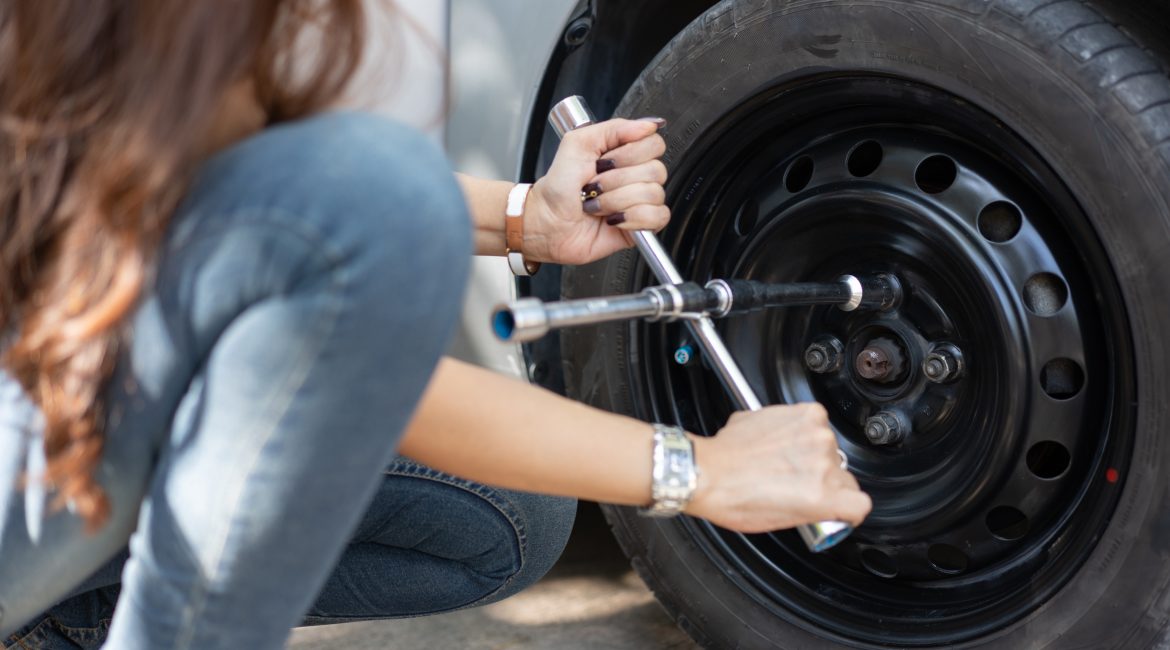Alright girls (and guys), it’s about time we all learnt how to change a tyre.
Why?
Because at some point everyone has to go through the hassle of dealing with a flat, and instead of calling an expert (which is costly) or a friend, partner or parent to help (which leaves you on the side of the road helplessly waiting for who knows how long – cue damsel in distress moment), grab your tools – don’t worry, we’ve got that checklist coming right up – and let’s get to changing!
Before we get started, if you are perhaps thinking that you don’t really need to learn how to change a tyre and there are people who can help you with that – then we suggest that you rethink your priorities – because this is something you need to know for your own safety and even the safety of others.
The fact of the matter is this, everyone should know how to change a tyre. It is one of those inevitable things that, as annoying and dirty as having a flat can sometimes be, it happens to everyone.
Being stranded on the side of who-knows-where with a flat tyre from who-knows-what is not exactly what we call a ‘safe situation’ to find yourself in. Regardless of the time it takes to wait for someone to come to your rescue, the risk you are taking in waiting alone on the side of the road and the time wasted in getting to where you want to go – it’s just not worth it.
Related: How to Jump Start a Car Safely: A Step-By-Step Guide
Besides, imagine being late for your hot date and telling him or her it’s because you had to change your flat – this is sure to impress the socks off your date! Changing a tyre is not as difficult as you may think and that’s why we have put together a simple guide to save you from those sorts of situations.
First things first
Make sure that your spare tyre or dummy wheel is not flat. Have this checked regularly at your local service station to ensure that the pressure and quality of the tyre are in check.
You should also have a look at your service book to see what your tyre pressure should be. Pop into your closest garage and have them pump your tyres regularly to this pressure reading.
The checklist part (this is pretty important)
As soon as you feel as though you may have a flat tyre – don’t freak out – just slowly get your car to a safe and flat area on the side of the road or in the emergency lane and bring it to a stop. It’s best to pull over as soon as possible because if the tyre is very flat it may damage your rims and wheel if you drive any further.
Then, the below checklist is of the utmost importance – you will need to ensure you have these things in the boot of your car. Another point to bear in mind is the location of your spare wheel – every car is different. Some spares may be located underneath your car and require some extra effort and time to detach and lower these down, others may be in the boot of your car or attached to the back door.
This is why we advise that you practice changing a tyre in the comfort of your own driveway to allow for you to feel more comfortable with the process and more importantly so, to guarantee you have all the tools you need!
The majority of cars will come standard with a tyre changing kit, but some may not. That’s why you will need to do a little boot digging to find out what your set of wheels has got and what you may need to find at your local hardware store or mechanic on your own accord.
What you need:
- Spare tyre
- Vehicle jack that is rated for the weight of your specific vehicle – the thing to prop your car up
- Lug wrench – the thing that looks like an ‘L’ and is used to remove the lug nuts from your wheel
- Torch with working batteries – yes, you may get a flat at night
- Wheel wedges – the things that are needed to hold your other wheels in place so that you don’t go running after a runaway car – as if having a flat tyre isn’t enough to deal with already
- Orange road cones – these are optional but really come in handy to warn other cars that you have pulled over for a flat
- Wet wipes, a folded towel and an old shirt – also optional, but if you find yourself having to change a flat on your way to some fancy business lunch, meeting or a date, then these things are recommended – we got you girl
The part on how to change a tyre (this is it, ladies)
Okay ladies (and lads), this is it, the moment you have all been waiting for – changing your tyre – can we get a drumroll, please? If you get a flat in more of an urban area, then try to slowly drive to a public place where you can park your car off the side of the road.
If you are on the highway, then park off the road as safely as you can or in the emergency lane. Try to make sure that the flat tyre is not on the side of the road with traffic – if you can. Ensure that the area is as flat as possible. If you have to risk a little damage to your rim of the flat tyre by driving a couple of meters to a safer spot – then it may just be worth it.
The easy bit with the parking and preparing
- Put your car in park or neutral, pull up your hand brake and switch on your hazards
- Erect your orange cones roughly 20m (20 big steps) behind your car
- Place your wheel wedges behind the other wheels (not the flat one), or logs, bricks or rocks (anything you can find) to stop your car from rolling away
- Grab your tools from your tboot (you may want to throw on your old spare clothes for this – simply slip them over your fancy clothes, if you don’t want to ruin your nice clothes).
- Get your spare tyre, lug wrench and jack from your trunk
- Place your spare tyre on the ground and not against your car as this may set off the balance when you jack the car up
Discover: Top Tips for Avoiding Pothole Damage: The South African Driver’s Guide
The tricky bit with the nut loosening
Prepare yourself for an epic battle of sorts if you don’t have any upper body strength because you are about to loosen the lug nuts with the lug wrench – remember the rule here – righty tighty and lefty loosey (this means if you turn something to the right, it will get tight and to the left it will loosen).
You are going to place the end of the lug wrench on each of the nuts and loosen each one.
You are not taking them off completely yet, just loosening them to remove easily when the car is jacked up. If you find some stubborn nuts, place your lug wrench so that you can stand on it – yes, stand on it. Use your weight to loosen the nuts while holding onto your car.
Please don’t fall and be ready to lose your balance as the lug wrench will move out from underneath you. This method is not always needed nor recommended for safety reasons, but it does the trick! In all honesty, this step is normally the hardest part.
The bit with the tyre changing
Amazingly, you have managed to loosen up the lug nuts – you go girl! Now you will need to jack up your car in order to remove the flat wheel. We advise that you are cautious as possible during this step as your car is incredibly heavy so make sure you get this bit right – no pressure.
Have a look in your car manual for the best place to put your jack. It will need to be solid and sturdy enough to hold your car up, this isn’t a guessing game. Place your jack under this sweet spot of strength.
Here comes the cool part – jacking up your car. You will need to know how to use your jack as each car may have a different one with different mechanisms and methods for jacking up the car. Do not place any part of your body under your car when you start to jack it up – this is just a disaster waiting to happen.
Now that you are is all jacked up, you will need to remove the nuts completely (good thing they are already pretty loose), put them in your pocket or on a clear area on the ground next to you to ensure you don’t lose one.
Alright, good job – now for the spare tyre placement! Now, placing your hands behind the flat wheel, after removing the nuts, pull the tyre off towards you. This tyre may be quite heavy, so prepare yourself for some sweating and upper body strength.
Placing your flat tyre on the ground, you will now place your spare onto the wheel. This may require a little adjusting – but fret not, it will get on there.
Read this: 6 Safe driving practices that just might save your life
The last bit with the nuts and bolts
You are almost there – well done! Now, take your lug nuts and screw them back onto the wheel with your fingers – just to get them in place. Do not tighten the nuts beside one another. Then use your lug wrench and tighten them into place – you will do this again when the car is lowered. Try to go in a crisscross formation to ensure even torque (so tighten one, then tighten the one opposite it, like in a star formation, repeat this a few times).
Grab your jack and attachments and begin the ease your car slowly back to the ground. Now listen up – do not lower your car too quickly and make sure no part of you is under your car – we really don’t recommend the whole sandwich effect, as this won’t be a good look for you. All jokes aside, be careful ladies.
Now that your car is back on solid ground, grab your lug wrench and tighten your bolts in a star or crisscross formation once again, as tight as you can. Righty tighty – how great is that saying?
You did it! Put your tools and flat tyre away, grab your cone, turn off your hazards and slowly pull back onto the road, driving slowly as most spare tyres can only go about 80km/h and for about 80km. Head over to your closest fuel station (most of these places can safely plug a tyre and replace your spare for you) or mechanic.
Depending on the severity and type of puncture, you may need a mechanic. Just make sure you change your spare back to a normal tyre ASAP.
The final bit
BRAG! Brag to everyone and anyone and tell them that you, yes you, changed your very own tyre – it’s liberating!
Of course, now that you know the simple way to change a tyre, why not find out more about the simple way to insure your car?
Your Insurance Family,
Oneplan




